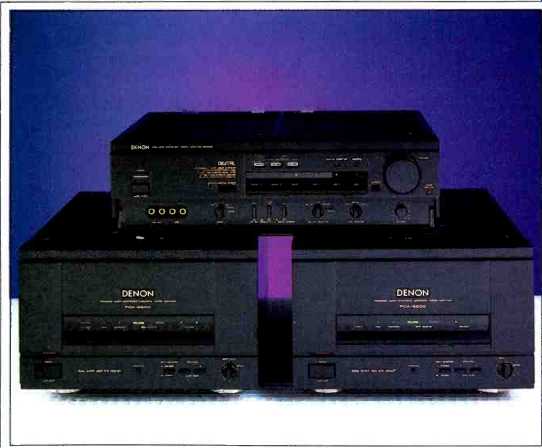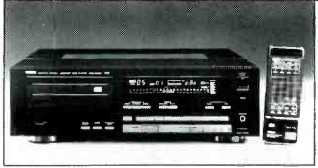SUMMER SUMMARY

above: Denon DAP-5500 digital preamplifier and POA-6600 amplifiers
Although what I call "glamortronics”--R-DAT, CD-V, and Super VHS machines--grabbed the spotlight at the 1987 Summer Consumer Electronics Show, there were many interesting new products reflecting advances in current technology.
There was plenty of activity in the preamp/amplifier category. A new product that caused quite a stir was Denon's DAP-5500 digital preamplifier.
This unit has coaxial and fiber-optic digital inputs, as well as normal line level analog inputs with RCA pin jacks.
With the digital inputs, CD players and DAT recorders equipped with digital output ports, and future equipment such as digital equalizers and surround-sound processors, can be directly connected. Furthermore, the DAP-5500 automatically adjusts to the 32-, 44.1-, or 48-kHz sampling rates of the various digital formats. With quadruple oversampling, the DAP-5500 uses two Denon "Super Linear" 16-bit D/A converters per channel in a "push-pull" configuration; one circuit processes the direct digital signal while the other processes an inverted-phase signal. Distortion in one converter tends to be cancelled out by equal but opposite distortion in the other. The resulting output signal is said to be of extremely high purity and precision.
The converted analog signals are passed through proprietary seventh order analog filters to remove residual ultrasonics. The resulting frequency response is specified as 2 Hz to 20 kHz, ±0.2 dB. THD is said to be below 0.002%. The claimed S/N ratio is 110 dB, with channel separation greater than 100 dB. The DAP-5500 features a balanced output with a very low (10-ohm) impedance, via XLR connectors. This enables long cable runs to balanced-input monoblock power amplifiers, if one wishes to place the amps near one's loudspeakers. Conventional unbalanced RCA jack outputs are also provided, No phono preamplifier inputs are included on this unit.
The DAP-5500 uses separate toroidal power transformers, and there is fiber-optic connection of analog and digital stages to ensure that no common ground exists between these sections. Much attention has been paid to special construction for low-noise performance. Extensive aluminum shielding is used between circuit boards, and the circuit boards are of high-resistance substrates. The chassis features heavy anti-resonant construction using Denon's laminated visco-elastic "silent steel." The DAP-5500 should be available around now at a price of $1,400. Denon's matching POA-6600 monoblock power amplifiers have balanced XLR inputs and are rated at 250 watts into 8 ohms. The units have no negative feedback circuitry and have a slew rate of ±500 V/µS. The amplifier is said to be stable with speaker impedances as low as 1 ohm. The POA6600 should be available now at a price of $700 per monoblock.
Perreaux introduced a real brute of an amplifier, the $4,295 PMF-5550, rated at 500 watts per channel into 8 ohms. This massive unit has a rise-time of 1µS. Its THD is said to be less than 0.03% at rated output and is claimed to be mostly even-order harmonics.
This amplifier is said to be capable of a continuous current output of 30 amperes, with phase shift of less than 2° at 20 Hz and 30 kHz. Frequency response is rated as flat within 0.5 dB from 10 Hz to 100 kHz.
Spurred by the success of their XL 280 amplifier, Hafler introduced the much more powerful Excelinear XL 600. With the same type of MOS-FET output circuitry as the XL-280, this new amplifier has an output of 305 watts per channel into 8 ohms and can handle loads as low as 1 ohm with an output of 900 watts per channel. Frequency response is rated at ±0.1 dB from 10 Hz to 50 kHz. Claimed phase shift is very impressive: Less than 0.25° from 20 Hz to 20 kHz. The XL-600 can be bridged for a mono output of 900 watts into 8 ohms. At $995 each, two XL-600 amps can provide a helluva lot of power at a reasonable price.
Spectral made a big splash at the SCES by demonstrating their long-awaited 200-watt-per-channel Class-A amplifier, the DMA-200. The amplifier is a dual-mono design on a single chassis. It is surprisingly compact, at 63/4 inches high, 19 inches wide, and 21 inches deep, but it weighs a hefty 92 pounds. The amplifier is beautifully crafted, reflecting Spectral's high-tech philosophy. The DMA-200 operates in pure Class A, with 200 watts per channel into 8 ohms and 380 watts into 4 ohms. Output current is rated at 32 amperes. Bandwidth is ultra-wide, extending from d.c. to 2 MHz. Distortion is said to be typically less than 0.006% at 200 watts per channel. Rise-time is very fast, at less than 300 nS. Slew rate is claimed to be 1,000 V/mS. Spectral was using Duntech Sovereign loudspeakers to demonstrate the DMA-200. This was the first exposure of these speakers at a CES, and these very revealing units superbly showed off the clean overall sound of Spectral's top amplifier. The immediacy of the transient response was startling.
Instrumental definition was exemplary, as were the well-focused image and depth perspective. Bass response extended to the sub-basement and was very clean and controlled. Particularly impressive was the combination's reproduction of the mighty 32-foot organ pedals on a Bainbridge CD, and of the smooth, high strings of a 30-ips master tape played on a Stellavox. No doubt about it, the Spectral DMA-200/Duntech Sovereign combination was a very convincing one, producing what many thought was the best sound at this CES. At $5,495, the DMA-200 is obviously an expensive amplifier, but I think the quality of its parts and construction and its splendid performance make it a good value.
CD players continue to proliferate, and the number of models in the low and mid-price category is truly staggering. As I have pointed out before, most of these CD players are the products of a relative few giant OEM suppliers and differ mainly in appearance, rather than in performance. Nonetheless, in this wildly competitive market segment, such features as quadruple oversampling, digital filtering, and elaborate programming facilities are becoming commonplace.
Yamaha plunged into the high-end CD market with their $2,200 CDX5000. Yamaha is claiming superior performance for this player because of a newly developed 18-bit D/A converter and a quadruple-oversampling 18 bit digital filter. Yamaha states that although the CD format uses 16 bits with a 44.1-kHz sampling rate, processing a 16-bit medium in a 16-bit format results in performance limitations such as quantization noise and phase problems. Yamaha claims that increasing the bit rate to 18 in the filter and D/A converters improves the accuracy of reading 16 fold and improves the S/N ratio by 12 dB. (Editor's Note: For a more detailed discussion of Yamaha's new system, see this issue's "Digital Domain." We plan to publish a review of this unit before the end of the year.) Needless to say, with Yamaha banging the drums about their 18-bit system, some of their competitors issued "white paper" technical bulletins challenging the worth of the higher bit rate, with much learned discussion about "floating points" and "parity bits." The general opinion in these tracts is that the extra bits are much ado about nothing. Nevertheless, Yamaha claims such impressive specifications as 100 dB of dynamic range and an S/N ratio of 115 dB.

-----Yamaha CDX-5000 CD player
Yamaha stresses such features on the CDX-5000 as a dual-layer anti-resonant chassis, a high-precision, virtually noiseless CD drawer, and direct access of 24 tracks with an access time of 0.7 S. The unit has a wireless remote control which, in addition to the usual functions, can adjust the player's 20-bit digital volume control. Deliveries of the CDX-5000 are slated to begin about now.
McIntosh was showing their new MCD7005 CD player, which features full 16-bit D/A converters for each channel and quadruple oversampling.
The unit has very fast track access and volume control via a wireless remote, with volume level displayed in the unit's "message center." The volume control is McIntosh's newly developed "Electronic Precision Ladder" attenuator. The MCD7005 can correct errors up to 8 bits longer than could be handled by the earlier MCD7000. The extremely rigid chassis, the extensive use of heavy machined parts (instead of stamped parts), and the precision CD drawer and drive system of the MCD7000 have been retained in this new player, which is available as you read this at a price of $1,599.
Technics showed their upscale SL P1000 CD player. This $1,000 unit has some unique features, including a fiber-optic digital output port as well as an electrical digital output port, evidently provided with a view toward interlinking future outboard digital equipment. Other features include a three layer damped chassis, two separate power transformers, and dual D/A converters with 96th-order filters. Volume can be remotely controlled, with a readout on the display panel. There is also a search dial affording precise backward or forward cueing with 0.04S increments in the slow mode. The SL-P1000 is currently available.
A recent survey indicated that 19 million CD players were in use throughout the world, and the CD juggernaut rolls inexorably on. Be that as it may, there are still a lot of folks out there who like the venerable vinyl disc. For the most dedicated (and well-heeled) aficionados of the LP, Ortofon has introduced their MC 3000, a no-holds barred moving-coil cartridge employing such new technology as a sintered ceramic aluminum-oxide cartridge body of extreme hardness, a carbon fiber cantilever and armature, a neodymium magnet, and a new stylus shape that is almost an analog of a cutting stylus. Recommended tracking force is 2.2 grams, and the claimed frequency range is 5 Hz to 90 kHz. In spite of the increased output of this cartridge, Ortofon recommends using it with their companion T 3000 step-up transformer. This unit is wound with linear-crystal, oxygen-free silver wire.
The MC 3000 is currently available at a price of $1,500, and the T 3000 is priced at $1,250. Magneplanar made its devotees happy with its new MG 2.5R loudspeaker. Its design is in line with that of other recent Magneplanars, but new advances have managed to extend bass response to below 40 Hz. This was evident on a number of recordings I auditioned on a pair of MG 2.5Rs.
Overall response was smooth and clean, with a nice, natural quality that I found appealing in listening to Previn's CD of Debussy's " Iberia." This speaker is priced at $1,550 per pair.
(adapted from Audio magazine, Oct. 1987; Bert Whyte)
= = = =